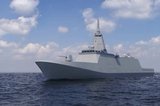UDT 2022: DSIT presents KnightShield task force underwater security system
Rendering of the KnightShield system in use. (Image: DSIT)
Defence and security solutions provider DSIT has showcased for the first time a mobile task force underwater security system called KnightShield.
As seen at the UDT event in Rotterdam on 7-9 June, the system supports the underwater protection of multiple ships within a naval task group while at port or other similar locations from swimmers, UUVs, SDVs, and sabotage attempts.
The 20ft (6.09m) ISO-containerised KnightShield is based on DSIT’s PointShield diver detection sonar system that provides medium-range coverage for multiple vessels while in port.
PointShield is designed as a ship-portable underwater security system that can be deployed in a narrow river,
Already have an account? Log in
Want to keep reading this article?
More from Naval Warfare
-
![Mitsubishi eyes future with Australia’s Mogami selection]()
Mitsubishi eyes future with Australia’s Mogami selection
With Australia’s selection of the Mogami-class for Project Sea 3000, Mitsubishi is investigating local production in the next decade as potential export opportunities emerge.
-
![Hanwha wins Australian government approval to increase its stake in Austal]()
Hanwha wins Australian government approval to increase its stake in Austal
The contract would mean the two shipbuilders can collaborate strategically and enhance shipbuilding capabilities in Western Australia.
-
![Royal Australian Navy sizes up modernisation plans for new and existing capabilities]()
Royal Australian Navy sizes up modernisation plans for new and existing capabilities
The Australian navy is pushing ahead with its efforts to modernise its workforce and capabilities while balancing risky submarine upgrades, ageing Collins-class boats and a shrinking minehunter fleet. Head of navy capability RAdm Stephen Hughes updated Shephard on the force’s progress.





















